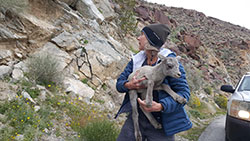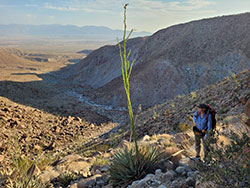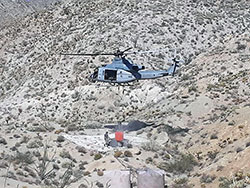Janene Colby, assisting thirsty lamb separated from its mother in border construction area.

Janene Colby, returning newborn lamb to its mother.

Janene Colby, hiiking in Harper Canyon, San Diego County.

helicopter delivering water for desert bighorn sheep project.
Janene Colby is an environmental scientist who studies bighorn sheep in the Peninsular Mountain Ranges of Southern California and southern mule deer in San Diego County. Working out of the CDFW San Diego office, she collects demographic data such as abundance, distribution, health status, survival and mortality causes on radio-collared and satellite collared bighorn sheep and mule deer.
She has a bachelor’s and master’s degrees in Science from California State University, San Marcos and began working with CDFW in 2005.
You started your career with CDFW a little later in life than a lot of our scientists. What were you doing before joining CDFW and how did that experience help determine your career path?
I worked at a wild animal park as an animal trainer for a North American mammal show. I became very disillusioned with training wild animals to perform for the public. While these animals are supposed to serve as “ambassadors,” it seemed more like entertainment for profit at the expense of the animal’s well-being. It was very disheartening, so I decided to go back to school and become a wildlife biologist.
What do you enjoy about working in the desert?
I like the stark beauty of vast spaces and being able to see the horizon – the orange glow cast on the desert mountains each sunrise and the brilliantly colored sky each sunset. I am a loner at heart and enjoy the solitude and quiet. I never tire of observing the beauty, adaptability and resilience of desert plants and animals.
Your big project in the summer of 2021 was to coordinate the delivery of water to several dry guzzlers in Anza-Borrego Desert State Park (ABDSP). Why was this important?
These particular guzzlers originally ran dry due to catastrophic failures in 2020 and were repaired, but there was not enough rainfall during the winter/spring months to refill the storage tanks in preparation for summer 2021. By September 2020, at least three radio-collared sheep had already died due to the dry guzzlers, and we recognized that there was an urgent need to get water into the two dry guzzlers before summer 2021. I did not want to witness more sheep deaths because we could not manage to find a way to get water into these guzzlers.
I reached out to California chapter of the Wild Sheep Foundation and the Society for the Conservation of Bighorn Sheep for assistance. Without the assistance of these organizations, and the U.S. Marine Corps, the helicopter water haul would not have occurred this summer.
What did this operation entail?
The most difficult part of the job was the timing -- just trying to get CDFW and Anza-Borrego Desert State Park (ABDSP) to act and get water into the wildlife water development system (guzzler) before the hot summer months when sheep would need to drink. ABDSP installed the guzzler in the 1980s but it had become dry due to lack of maintenance, and they were unable to commit the necessary time or money to get water to it. And while CDFW had good intentions, we are currently not set up with funding or the ability to quickly secure a helicopter contract for emergency water hauls to remote locations. When it became clear that our agency would not be able to get water into the guzzler before the end of summer, I contacted the California Chapter of the Wild Sheep Foundation (Cal WSF) and the Society for the Conservation of Bighorn Sheep (SCBS). These two nonprofits were able to secure funding for the project and reach out to the Marines at Camp Pendleton for help.
On Aug. 27, a base camp was set up within the State Park that was approximately 10 miles from the guzzler. Temporary portable water tanks were set up and water trucks delivered 12,000 gallons of water. In the evening, the Marines Light Attack Training Squadron 303 (HMLAT-303) and 1st Marine Raider Support Battalion (1MRSB) arrived at base camp in a UH-1Y helicopter. A safety briefing was held, and the logistics of hauling water was discussed. At dawn on Aug. 28, the UH-1Y helicopter crew long-lined a stock tank 10 miles to the guzzler. Next, the helicopter crew dipped a “bambi bucket” that can hold up to 225 gallons of water into the portable water tank, flew the bucket of water to the guzzler and dumped it into the stock tank, which would then feed the water into the guzzler storage tank. This procedure was repeated seven times until it became too hot and windy for the helicopter to continue safely. By 11 a.m., approximately 1,600 gallons of water had been delivered to the guzzler. We really needed to get water to this endangered population of peninsular desert bighorn sheep at the beginning of the summer rather than at the end of the summer. However, it will hopefully help them out until the first rains arrive in November or December.
CDFW often states that wildlife should be left alone, with minimal human intervention. Why is this different? Why do we need to deliver water to species that should theoretically know how to find water on their own?
Wildlife can only find water on their own if there is water to be had! Bighorn sheep and other desert dwellers are well adapted to extreme desert conditions. In times of drought, bighorn sheep can adjust their behavior to conserve water and can seek out plants such as cactus and other succulents that contain a high concentration of water. However, an increase in mean temperature and decrease in annual precipitation within the desert due to climate change has resulted in a measurable decrease in the quality and quantity of natural water sources and vegetation available for use by desert bighorn sheep and other species.
So in this case, human intervention was necessary?
Most plants and animals on the endangered species list are there due to direct and/or indirect anthropogenic changes to their habitat. Peninsular bighorn sheep were federally listed as endangered species in 1998 due to human caused habitat loss, degradation, fragmentation, drought and disease introduced by domestic livestock. Humans created the problem. If we value wildlife, then it is incumbent upon us to help support these animals until we can find a more permanent solution by decreasing greenhouse gas emissions and preserving and protecting the habitat that remains intact.
Was this a one-time operation or will it be necessary to repeat?
I hope it will not be necessary every year, or even every drought year. But until we study this in more depth we will not know. Due to climate change, it is more important than ever before to carefully monitor and maintain wildlife water developments and invest in more efficient systems with greater storage capacity. To achieve this goal, CDFW and other state agencies like ABDSP need to commit both money and personnel to this task sooner rather than later.
How did you feel upon the successful completion of the water delivery? Relieved? Satisfied?
I truly enjoy and am passionate about my job, but I don’t think I’ve ever felt “satisfied” with this job. If and when we can ensure bighorn sheep will thrive into the future, then I’ll be satisfied. But I don’t think we are there yet.
Outside of this major project, what other kind of work do you typically do?
Checking on the status of radio-collared bighorn sheep is time-consuming, as it entails driving on rough Jeep roads for four to six hours a day, followed by hiking in remote areas for several hours. In an average year, I conduct 40 to 50 sheep and deer mortality investigations. I spend a fair amount of time at my computer doing data entry, processing satellite and GPS data and creating home range maps in ArcGIS, and compiling and analyzing data for technical reports. I also help plan and implement sheep and deer helicopter surveys and captures.
What kind of projects are in your future?
With an unlimited budget and unlimited time, I would set up a long-term study to measure the impacts of climate change on bighorn sheep, and evaluate what management tools would be needed to alleviate or reduce impacts. But I’m not too far from retirement. Even after I leave the department, I will continue to be an advocate for protecting and preserving wildlife habitat. I have not yet had time to give this much thought beyond knowing that I will continue to be an advocate after I retire. I cannot just “relax” in retirement when there is so much more that needs to be done – that is just how I roll.
CDFW Photos